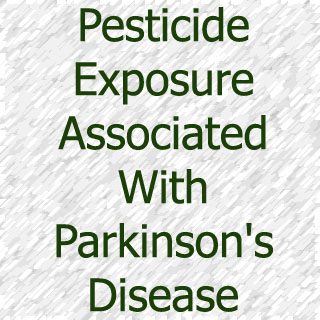
Parkinson's Disease Linked to
Exposure to Pesticides
Aug 2012
A review of research from Belgium's Catholic University of Louvain has confirmed
that Parkinson's disease is linked to occupational exposure to pesticides.
The researchers, working with the Louvain Center for Toxicology and Applied
Pharmacology, analyzed studies between 1985 and 2011 that looked at pesticide
exposure by workers who handled pesticides. These included farm workers who
sprayed pesticides.
The overall conclusion of the research found that those who handled pesticides
were significantly more likely to contract Parkinson's disease. In four studies,
where the Parkinson's diagnoses were confirmed by neurologists, those handling
pesticides had an average of over two-and-a-half times the risk of contracting
Parkinson's disease. The increased risk ranged from 46% higher to almost
four-and-a-half times higher among the workers.
Three cohort studies, which followed larger populations and compared them to the
general population, concluded that workers handling pesticides had close to
twice the risk of contracting Parkinson's disease than the rest of the
population. (It should also be noted that the general population typically also
has constant contact with pesticide residue in the form of foods and household
pesticides.)
One of these cohort studies showed workers handling pesticides had almost three
times the rate of contracting Parkinson's disease.
The researchers found significant rates of increased Parkinson's disease risk
among workers in banana plantations, sugarcane fields and pineapple farms.
An Avalanche of Neurotoxic Pesticides
Today over five billion pounds of pesticides are applied to our crops,
households and other areas we share with insects. Many of these pesticides have
been shown to be neurotoxic - they damage nerves and nerve transmission.
Three-quarters of the twelve most dangerous chemicals (aka the "dirty dozen")
used by man are pesticides according to the Stockholm Convention on Persistent
Organic Pollutants.
Many of these pesticides have been proven to be neurotoxins. Organochlorine
hydrocarbons are one of the most widely used types of pesticides in commercial
farming enterprises. These include DDT (dichlorodiphenyltrichloro
Today many of the organochlorines have been replaced by organophosphates, but
these will alter neurons by blocking cholinesterase enzymes. Cholinesterase
enzymes such as acetylcholinesterase are acetylcholine inhibitors. Increased
acetylcholine availability leads to excessive to neuron firing, resulting in
nerve excitability, long term nervousness, nerve weakness and even paralysis.
This was confirmed in a recent study from the University of California,
Berkeley, which tested Mexican-American mothers and their children living in
agricultural regions with higher pesticide exposure. The researchers monitored
202 mother-and-daughter pairs for relative levels of paraoxonase,
acetylcholinesterase, and butyrylcholinesterase enzymes and their respective
activity among neurons. The researchers confirmed that pesticide exposures not
only affect adult acetylcholinesterase levels, but also affect children under
the age of nine years old more than adults. They also concluded that children
born of pesticide-exposed parents have even lower levels of acetylcholinesterase
– relating to the higher risks of nerve disorders.
Other pesticides, such as imidacloprid and related neonicotinoids are
neurotoxins in turn bind to nicotinic acetylcholine receptors – important to
healthy nerve firing. These pesticides are also suspected in bee colony collapse
disorder.
Manufacturers of neonicotinoid pesticides have claimed that the chemicals will
not affect human acetylcholine receptors. However, a study by researchers from
the Tokyo Metropolitan Institute of Medical Science released this February found
that the neonicotinoids imidacloprid and acetamiprid "had greater effects on
mammalian neurons than those previously reported in binding assay studies."
Pesticide residues for the rest of us
As for those of us not handling pesticides on the job or at home, our pesticide
exposure comes from pesticide residues in our foods and homes sprayed for bugs.
Pesticide residues are found on a majority of commercially grown foods. In a
review of the research by Cornell University's Dr. David Pimentel, 73% to 90% of
conventional fruits and vegetables contain pesticide residues, with at least 5%
of those pesticide levels above FDA tolerance limits.
While the cost of organic foods might be a tad higher in the store, the price
paid in the long run for pesticides in terms of liver disorders and nervous
disorders such as Parkinson's - as well as environmental damage to our bees,
waterways and soils - makes the real price for organic foods cheap in
comparison.
REFERENCES
Van Maele-Fabry G, Hoet P, Vilain F, Lison D. Occupational exposure to
pesticides and Parkinson's disease: a systematic review and meta-analysis of
cohort studies. Environ Int. 2012 Oct 1;46:30-43.
Gonzalez V, Huen K, Venkat S, Pratt K, Xiang P, Harley KG, Kogut K, Trujillo CM,
Bradman A, Eskenazi B, Holland NT. Cholinesterase and paraoxonase (PON1) enzyme
activities in Mexican-American mothers and children from an agricultural
community. J Expo Sci Environ Epidemiol. 2012 Jul 4.
Stockholm Convention. Available at
http://chm.pops.int/
Kimura-Kuroda J, Komuta Y, Kuroda Y, Hayashi M, Kawano H. Nicotine-like effects
of the neonicotinoid insecticides acetamiprid and imidacloprid on cerebellar
neurons from neonatal rats. PLoS One. 2012;7(2):e32432.
Pimentel D. Environmental and Economic Costs of the Application of Pesticides
Primarily in the United States. Environment, Development and Sustainability.
2005. 7: 229-252.
Adams C. The Living Cleanse: Detoxification and Cleansing Using Living Foods and
Safe Natural Strategies. Logical Books, 2011.
http://
